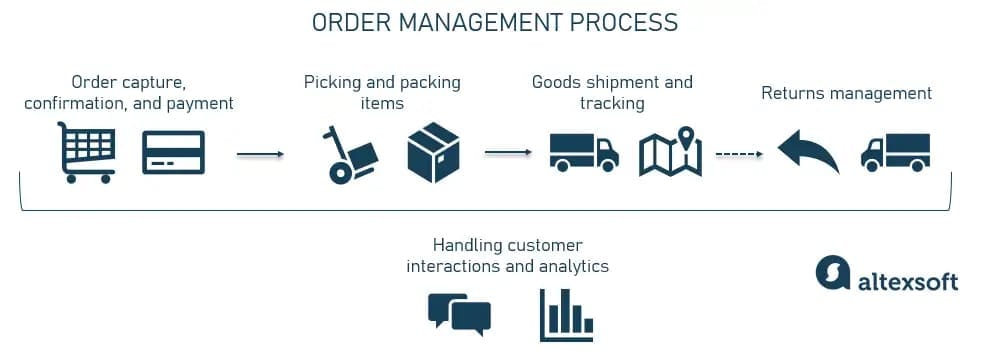Any business wants its customers to be happy and stay loyal to the brand. But customer satisfaction is influenced by an intricate combination of factors, including price, product quality, level of service – and also speed and accuracy of order fulfillment.
If you don’t deliver on time or send the wrong item, most likely you’ll lose the customer (right after listening to their complaints). On top of that, shipping errors might cost you an additional $300 per incident – sounds pretty unpleasant, doesn’t it?
Order management is a complex process that requires a lot of attention and coordination if you want everything to function smoothly. So today we look at its main components, challenges, and solutions that might help you streamline fulfillment and make customers happy.
What is order management?
Order management is a set of activities related to processing customer orders in goods-based companies. Efficient order management aims to increase the buyer’s satisfaction and loyalty by delivering the right product to the right customer at the right time.
Before we delve into the details of how order management works, let’s clear up a few terms.
Order fulfillment vs order management
Order management is a broader concept than order fulfillment, even though they are often used interchangeably. The former relates to overseeing the entire order lifecycle, including administrative components, while the latter mostly focuses on logistics and the physical delivery of goods to the customer.
The order management workflow encompasses all the business activities from checkout to delivery to post-purchase interactions with the customers. And that usually requires the synchronized efforts of almost all company departments (customer service, warehouse staff, accounting, etc.) as well as external partners such as shipping service providers.
Inventory management vs order management
The main objective of inventory management is controlling stock levels (reordering, tracking, forecasting replenishment, etc.), while order management focuses on handling customer orders throughout the entire sales process – and that’s the main difference.
However, these two concepts have a lot in common and work together since both deal with goods you sell and cover overlapping inventory-related workflows. So if you look at the digital systems that automate order management and inventory management, you’ll see that their functionality is remarkably similar.
Order management process
So now let’s discuss the main order management components. As we follow the order journey, you’ll see that managing them manually is only possible when running a small business that only deals with a handful of orders. Anything bigger than that requires process automation and the usage of specialized software, which we’ll talk about further.

Main order management stages
Please note that all businesses are different and might have diverse order management workflows, so we’ll mainly focus on the common eCommerce shipping scenario.
Order capture. Nowadays, most businesses use a number of sales channels to distribute their goods, including brick-and-mortar stores, eCommerce platforms, online marketplaces, etc. The usual eCommerce order journey begins at the moment the customer clicks the “Buy” button. After that, you have to verify goods availability and confirm the order. Then, after payment is processed, the order is transferred to the fulfillment team.
You can read more about an omnichannel strategy and how to build it in our dedicated post.
Picking and packing. That’s the stage where order management is intertwined with warehouse management, as the SKUs must be found in the storage space, picked, and packed to get them ready for shipping.
Shipping and tracking. Delivering shipments to the customer is a crucial step. Whether you operate on a dropshipping model or have a fleet of trucks to haul goods from your warehouses, you want your goods to be delivered on time. Another thing of huge importance nowadays is providing your customers with an opportunity to track their purchases in real time since that’s what over 90 percent of them want.
Returns management. The order management process doesn’t end with handing goods to the customer. Sometimes, customers initiate returns and/or exchanges – and managing the backward movement along the supply chain is a whole new story (please read about reverse logistics in our dedicated post).
Handling interactions with customers and analytics. Post-purchase follow-up activity is important for building brand awareness and customer loyalty. Capturing and storing customer data is vital for further communication and analysis – but is barely possible without specialized software tools. So is analytics in general, which is required for accurate forecasting of future activities.
As we said, once you scale your business to selling through several channels and shipping multiple orders a day, managing all that manually becomes too complicated. So let’s talk about what software tools can bring to the table and how they can make your life easier.
Order management systems: key features and benefits
An order management system (OMS) is a digital tool that automates and streamlines order processing operations, increasing overall efficiency, accuracy, and visibility. It works best when integrated with other systems within the company’s IT infrastructure for seamless data exchange.
An OMS can help you cope with multichannel sales, accurately fulfill orders, forecast inventory levels, and get a bird’s-eye view of your business operations. To better demonstrate its features, let’s follow the standard order journey again -- but this time with the OMS in place -- to see how it might increase efficiency and reduce lead time.
Order capture
OMS capabilities and benefits: omnichannel/multichannel order processing, customer data management, data storage and exchange between systems
An OMS works with all the points of sale you have set up, aggregating order information from all of them and transferring it to a single portal or database. You know that if your sales channels aren’t synchronized, you risk double selling items or selling goods that are no longer available.
So once the customer places the order in one of the channels, an OMS automatically captures it and triggers a chain of events:
- verifying goods availability (most OMSs have inbuilt inventory management functionality, or you can integrate it with your existing system or an ERP),
- getting payment information from the integrated processing solution,
- collecting customer details (again, you can use the out-of-the-box CRM capabilities or integrate with your own customer database),
- sending a confirmation message to the customer, and
- transferring order details to the fulfillment team at the nearest location.
By the end of this stage, you have accurate order details stored in your system and automatically passed on to the fulfillment staff with no manual intervention needed.
Picking and packing
OMS capabilities and benefits: stock level control, barcode integration, printing shipping labels, calculating costs
As we said, a full-fledged OMS helps you control your inventory levels by forecasting changes and setting optimal replenishment schedules so that you avoid both understocking and overstocking.
In the warehouse, the OMS helps find the right items with the help of barcode/RFID tags and generates a shipping label using the customer details from its database. You’ll be able to set up business rules (e.g., choose between FIFO/LIFO/FEFO methods) on how to handle different SKUs or SKU groups, as well as ones related to split or combined shipments.
The OMS also compares shipping options across your carrier partners and automatically calculates the shipping expenses.
If you’re interested in partnering and integrating with logistics services providers, check our detailed article about various shipping APIs in the transportation industry.
Shipping and tracking
OMS capabilities and benefits: real-time tracking, sending tracking notifications, dropshipping support
An OMS gets an ETA and other tracking information from the integrated transportation management system or from an external logistics service provider. Now, both you and the customer can have peace of mind as to where the shipment is and know when it will arrive.
If you operate on the dropshipping model, most OMSs support that as well, transferring the order details right to your suppliers and logistics providers.
Returns management
OMS capabilities and benefits: return shipping label generation, return status tracking
To support reverse logistics, a robust OMS generates a return shipping label and helps you track delivery and refund status.
Handling interactions with customers and analytics
OMS capabilities and benefits: automated follow-ups, customer data management, reports generation, analytics
As we said above, the OMS captures all the customer details and allows you to automate follow-up activities, such as post-purchase emails with feedback requests, surveys, marketing newsletters, etc. And equipping your customer service team with a complete CRM database will improve service, increase customer engagement, and provide more cross-selling opportunities.
As you can see, the main challenges within order management are related to human error, poor communication, and, therefore, a high risk of inaccuracies. But there are other difficulties that you’ll face when trying to manage your order lifecycle manually or with the help of legacy tools, i.e.,
- lack of overall visibility into your activities due to siloed digital systems,
- high shipping costs if you use nonoptimal shipping methods, or
- hardly any opportunities for supply-chain analytics and, therefore, forecasting and efficient business planning.
Because it captures and stores all the important information, an OMS is a great way to get better visibility into your activities. It provides you with
- order processing status;
- up-to-date inventory details;
- records of customer orders, returns, and refunds;
- information on billing and payments;
- databases of suppliers and customers;
- general ledger information; and so on.
It’s nothing but convenient to have all data stored in one place. This way, the system can generate various reports and dashboards with important metrics. It’s a powerful analytics tool that helps you track your KPIs, define areas that require improvement, and make forecasts regarding future sales and inventory levels.
How to choose order management software?
A simple Google search will give you a list of the top-rated order management systems and their detailed descriptions. Among them are such recognized providers as
- QuickBooks,
- Oracle with its NetSuite,
- Zoho,
- Salesforce,
- SAP,
- Brightpearl,
- ShipStation, and many others.
All of them have tons of useful features, so the tough question here is, “How to choose the right one?” Unfortunately, there’s no universal answer (otherwise, there would’ve been just one product on the market, right?), but we can give you a few tips that will hopefully be helpful.
Define your weak areas and business needs
That sounds pretty obvious, but in reality, not all business owners know what exactly they need to improve and streamline their activities. So what is your main problem? Do you often run out of stock? Or deliver too many erroneous shipments? Or spend too much time on follow-up activities? Once you know which workflows require enhancement, you know what functionality you need.
Alternatively, you might find out that it’s easier for you to outsource the complete order fulfillment process to a third party and focus on the administrative side. It’s also a viable option that will take a lot of heat off you, but make sure the cost is worth it.
Assess your existing IT infrastructure
If you still want to handle your orders yourself, look at the systems you’re currently using and think if there are ways to optimize your operations with existing resources. For example, if you’re on Shopify, check out their enterprise pricing plans – what if that functionality is enough for your current needs? Or maybe you have an ERP/IMS/WMS – talk to the provider to see if the platform can be customized to fit your requirements. Even if you find out that you need to build an extra feature, it might be easier and cheaper than implementing a whole new system.
Compare off-the-shelf OMSs
If you’re absolutely sure that you need one more tool, here are some aspects to look at closely. Also, remember that order management software is very similar to inventory management solutions so you might want to check both categories.
Functionality. Obviously, the selected tool must have the features that will help you improve your operations. But the devil is in the details. For example, you might need to check if it supports multiple currencies or sends automated SMS tracking notifications. Does it have a mobile app? Is the range of reports enough for you? How many sales channels (and which) does it support? How about international shipping or B2B sales support?
Pricing. This one is debatable because sometimes it’s worth paying a little more but get a wider range of capabilities, so you’ll have to do some calculations here and try to predict the ROI.
Integrations. This part is crucial as it’s what seamless data exchange depends on. The OMS must have a list of preintegrated partners so that you can connect both internal systems (WMS, ERP, accounting, payment processing, etc.) and external logistics service providers like couriers or 3PLs.
Customization options. Most likely, you’ll need to customize the OMS to fit you better. You might want to print branded shipping labels or set up custom pricing policies. Check if the provider offers any customization services and the price.
User-friendliness. Always test the waters before committing and check how complex the new solution is. Remember you’ll have to train your staff how to operate the new system so it’d better have an intuitive interface. The less time it takes, the sooner you can get back in the race.
Support. Make sure that post-purchase support and maintenance is provided and customer service is available. You might also want to read some reviews to get a fuller picture.
Scalability. Last but not least, check if the selected solution will be able to support your business growth as you add more channels, more goods, more markets, and so on.
Consider building a custom OMS
To buy or build is the eternal question many business owners face. The pros and cons are obvious: You either acquire a ready-made product straight away with the risk of not covering your business needs perfectly – or jump into a lengthy, costly development project to get a tool absolutely tailored to your workflows.
Again, there’s no one recommendation for every case. But in general, it makes sense to consider developing your own solution in case you’re an ambitious, enterprise-scaled company with multiple unique workflows. Otherwise, many ready-made platforms today offer sophisticated features and plenty of customization opportunities that meet the needs of smaller businesses.

Maria is a curious researcher, passionate about discovering how technologies change the world. She started her career in logistics but has dedicated the last five years to exploring travel tech, large travel businesses, and product management best practices.
Want to write an article for our blog? Read our requirements and guidelines to become a contributor.

